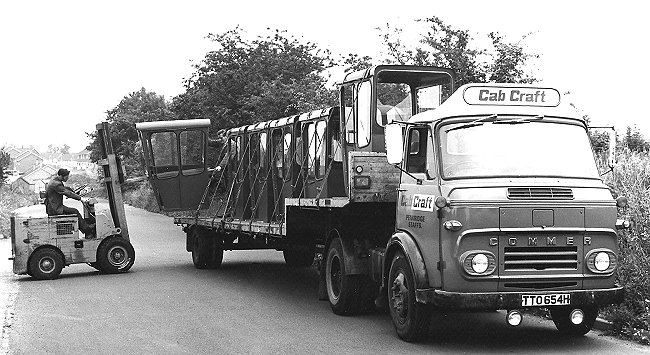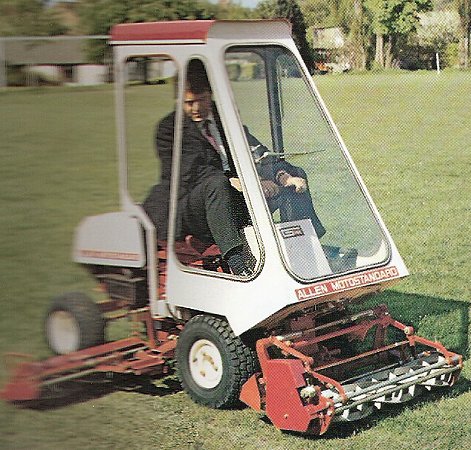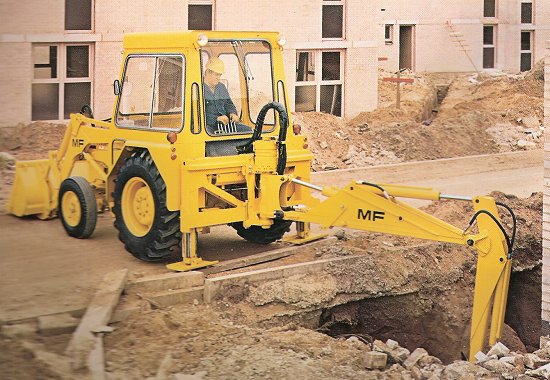|
The
story of a successful company that has its roots in
Wolverhampton
Albert Douglas (Doug) Barker, born in 1917,
recalled this period of his life as Managing Director
of Cab-Craft Limited to his son John, and daughter
Julie, leading up to his 93rd birthday.
|
| Beginnings and Growth I recently read with great interest Charles Weight's
account in the Wolverhampton Museum archive about the
early years of development of tractor cab manufacturers
based in and around the Wolverhampton area. However, the
penultimate sentence in his story is a bit misleading in
that Cab-Craft Limited - then owned by their factory
landlords: the David Charles Group - actually went on to
acquire his larger Tractorvision company at Four Ashes.
This was shortly after David Charles invited me to join
Cab-Craft Ltd. as Managing Director at their Penkridge
works - replacing Dave Thomas in 1967. I held that post
up to my retirement due to ill health in 1977.
My first
task at Cab-Craft was the urgent need to improve
productivity which I did by employing an inspector/rate
setter and introducing a fair to both sides piece-work
incentive bonus.
The scheme was modelled on one I had
recently devised when I set up the production line for
ISO freight containers at Metropolitan Cammell. The shop
floor workers immediately enjoyed substantially higher
wages and the finished cabs rolled out of the door at a
much faster speed. |

Doug Barker. |
| When we first took it over, the TractorVision
factory was owned by the Caterpillar Distributor Bowmaker Plant. It
was a loss making, union organised factory with a history of poor
industrial relations. We bought the business because we urgently
needed more production and storage space as we had outgrown our
factory. The smaller plant at Penkridge was non union, making good
profits and was becoming increasingly restricted by small premises
with no external area for holding stock.
The factories were four
miles apart, both located on rural industrial estates between
Wolverhampton and Stafford and were run as two separate production
operations but with common use of the design and purchasing
facilities in the Four Ashes office block. Head office (including
Sales and Accounts) remained at Penkridge. Over the years, the two
shop floor workforces continued to refuse to co-operate and I
reached the conclusion that they would never have worked
harmoniously in one large factory. I soon introduced the same
piece-work scheme which had proved so successful a year earlier at
Penkridge and within weeks, this factory was also returned to
profitability. I was now confident that we could
build-up the business using internally generated
income helped by the David Charles Group who supported
us strongly in the early stages of growth. |

| Fuelled by tougher U.K. Health & Safety
legislation, the 70's decade saw a huge development in the market
for safety cabins for tractors, combine harvesters, earthmovers and
handling trucks. Cab-Craft grew rapidly to become the dominant
player in the U.K. cab industry (there were 5 other companies
contesting the market at that time) and we enjoyed a fine record of
annual growth and profitability under my stewardship.We also became
substantial exporters too shipping cabs to Ireland, Scandinavia and
several other countries around Europe. My skills in welded
fabrications and more latterly in selling combined well with our
design & development team. We formed a prototype unit and designed
many well-styled cabs which looked to be an integral part of the
machine. Dealers and end users liked our designs and the business
thrived and grew. So Charles Weight's final 'amen' to Cab-Craft in
his Tractorvision archive was somewhat premature! The final 'Amen'
was to come a decade later. |
|

An Allen grass cutter fitted with
a Cab-Craft cab. |
Over 10 years, I built the Cab-Craft business
from well under £1m annual turnover to over £5m annual turnover, with year-on-year increases in net profit, culminating in over £1m
net profit in1975/6.
My son John Barker joined the business as Sales
& Marketing Director in 1974 with agreement by David Charles for him
to take my position as M.D. after 6-months. John developed and
agreed a ten year plan with Group to diversify the
business to keep the company healthy when the
independent cab business started its inevitable decline.
But by1975, we became increasingly worried about the
desperate cash shortage within the parent Group. We were
able to help and following an excellent 1976/7 financial
year, we forwarded a record £1.1 million net profit to
our owners. |
| Imagine our dismay when 6-months later - the banks
insisted on the appointment of their nominated Director
to the Group's Board shortly afterward. All the
Directors of subsidiary companies were called in to Head
Office to meet him - where we received his assurance
that his bank would see them through their temporary
cash flow crisis. A few weeks later, they forced the
Group into Receivership/liquidation and closed-down many
of the Building Division companies. Cross guarantees
right across the Group saw the Receivers Cork Gully
coming in to all the profitable companies - us included
- to immediately manage our business. To our surprise,
they waved their cheque book at us and we returned to
full production the following day. |
| As we were still a
rising star, we received financial backing paying cash with order to
all our suppliers. Six months later, we were put up for sale as a
debt free going concern. We spent 6 months being interviewed by
several prospective purchasers and against all the odds were
snapped-up on the last day for sealed bids by the Mitchell Cotts
Group, who operated a large warehousing complex adjoining the Penkridge
factory.
They paid £1.2 million for the business. Arguably an
overly generous sum for a low asset company such as ours
working in three rented properties.
They were looking to buy a successful farm machinery
manufacturer and had very little time to carry out
due diligence enquiries. |

A Clark tractor
equipped by Cab-Craft, is dwarfed by a Jumbo Jet at
London's Heathrow airport. |
| We were employing 340 people at the time and working
two shifts out of our 3 factories, and building several
thousand very sophisticated safety/quiet cabs each year,
including the insulation and fitting of our newly
developed cabs on to all new Massey Ferguson 240/265
series tractors sold in the UK, in a new assembly
factory we had very recently rented in Shaw Lane,
Wolverhampton.
I am proud to say that nobody lost their job at that
time and the Directors and staff all received generous
contracts of employment at 'terms no less favourable
than previous'. My only regret was that because of Group
cross guarantees to maximise their borrowing facility
our key suppliers lost a lot of money as there was no
creditors payout after preferential creditors had
received their dues from the Group.
I was due to take early retirement that
year, and I personally lost a small fortune as all my profit related
bonuses went into buying David Charles Group shares, with a face
value worth over £250,000 the year before the property market and
land values collapsed, which resulted in the building Group's
failure.
This was a bad time for me and my health deteriorated
rapidly. David Charles was a good house building company holding a
very large high value land bank at the wrong time. Within 9 months
of the liquidation of the central business, land values recovered to
record levels, and so another good Midlands company bit the dust
for the sake of not receiving short term support from their bankers
(there was no quantative easing in those days).
Mitchell Cotts
actually agreed to buy Temperate Filtration Limited, a key supplier of
air filtration units, as we were their main customer and we needed
continuity of supply. So Cab-Craft Limited became part of the Mitchell Cotts Engineering Division, headed by the then M.D. Dennis Hands.
They were not too familiar with the fast pace of the sheet
metalworking sector, but they soon came to realise that our working
practices were quite different!
To their credit, they invested in
our business by agreeing to the purchase of an N.C. automatic punch
press, an N.C. back-stop controlled press, and freed-up a
neighbouring warehouse at Penkridge to bring production potential up
to the level of the Four Ashes site. |

A Massey-Ferguson 40 digger loader fitted with
a Cab-Craft safety cab.
|
I had a great team at Cab-Craft who played a
large part in the development of the business. It is an interesting
story, so I thought it worth recording in the archive. It was the
most satisfying post I ever held because we must have saved many
lives as well as dramatically improving the health and life span of
many farmers and their workers. I will always be proud of that
achievement.
Here's a summary of what we
achieved together, thanks in particular to Peter York
(Technical Director), John Barker (Sales & Marketing
Director), Graham Bustin, and Ron Baldwin, who all
worked so enthusiastically to meet the development
challenges of a rapidly developing market. We became top
dog in the industry because over 75% of our products by
value were sold directly to dealers and end users. In
this way, we controlled our marketing and pricing
without allowing manufacturers to push prices downward.
This proportion was to reverse over time as the vehicle
manufacturers wanted and obtained a larger slice of this
business.
To the best of my knowledge, we never received
any acknowledgement or award from the Government, the N.I.A.E, or
the N.F.U. for our pioneering health and safety work. I do recall
reading in the Birmingham Post that 3 or 4 people working for the
National Institute of Agricultural Engineering received awards in
the New Year Honours lists for their work in developing safety cabs.
Their contribution was mainly to develop a cab testing procedure. It was the cab companies, like us, that did all the development
work on the safety frames and on the noise deadening work.
More
important than awards, we were always very pleased to receive the
thanks and best wishes from thousands of farmers (and particularly
from their wives) when we met them at the various Royal and the
Smithfield Shows. They were thankful for our dramatically improving
working conditions and keeping their husbands and sons safe and
well. At that time, fatal accidents on farms were running at an
all-time high, and lung disease amongst older farmers was also
emerging as a slow killer, rather like pneumoconiosis in the mining
industry. |
 |
|
 |
Return to the
engineering hall |
|
Proceed to Combine
Harvester Cabs |
|